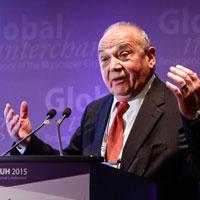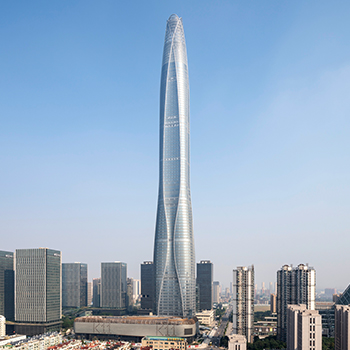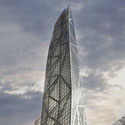Filter by
You must be a CTBUH Member to view this resource.
53 West 53
53W53, 53 West 53 Above MoMA, MoMA Expansion Tower, Tour de Verre
Building
Completed, 2019
10019
residential
concrete
320.1 m / 1,050 ft
77
2
162
6
7.1 m/s
67,355 m² / 725,003 ft²
You must be a CTBUH Member to view this resource.
You must be a CTBUH Member to view this resource.
Usually takes on the balance of the architectural effort not executed by the "Design Architect," typically responsible for the construction documents, conforming to local codes, etc. May often be referred to as "Executive," "Associate," or "Local" Architect, however, for consistency CTBUH uses the term "Architect of Record" exclusively.
Other Consultant refers to other organizations which provided significant consultation services for a building project (e.g. wind consultants, environmental consultants, fire and life safety consultants, etc).
Material Supplier refers to organizations which supplied significant systems/materials for a building project (e.g. elevator suppliers, facade suppliers, etc).
You must be a CTBUH Member to view this resource.
Usually involved in the front end design, with a "typical" condition being that of a leadership role through either Schematic Design or Design Development, and then a monitoring role through the CD and CA phases.
Usually takes on the balance of the architectural effort not executed by the "Design Architect," typically responsible for the construction documents, conforming to local codes, etc. May often be referred to as "Executive," "Associate," or "Local" Architect, however, for consistency CTBUH uses the term "Architect of Record" exclusively.
The Design Engineer is usually involved in the front end design, typically taking the leadership role in the Schematic Design and Design Development, and then a monitoring role through the CD and CA phases.
The Design Engineer is usually involved in the front end design, typically taking the leadership role in the Schematic Design and Design Development, and then a monitoring role through the CD and CA phases.
The main contractor is the supervisory contractor of all construction work on a project, management of sub-contractors and vendors, etc. May be referred to as "Construction Manager," however, for consistency CTBUH uses the term "Main Contractor" exclusively.
Other Consultant refers to other organizations which provided significant consultation services for a building project (e.g. wind consultants, environmental consultants, fire and life safety consultants, etc).
These are firms that consult on the design of a building's façade. May often be referred to as "Cladding," "Envelope," "Exterior Wall," or "Curtain Wall" Consultant, however, for consistency CTBUH uses the term "Façade Consultant" exclusively.
Material Supplier refers to organizations which supplied significant systems/materials for a building project (e.g. elevator suppliers, facade suppliers, etc).
Best Tall Building 300-399 meters 2021 Award of Excellence
2021 CTBUH Awards
CTBUH Releases Year in Review: Tall Trends of 2019
12 December 2019 - CTBUH Research
CTBUH Study Examines Tallest Buildings with Dampers
22 August 2018 - CTBUH Research

26 October 2015 | New York City
The New Supers: Super-Slender Towers of New York
432 Park Avenue, the MoMA Tower and Steinway Tower at 111 West 57th Street are the first of a new generation of supertall buildings in...

12 December 2019
Year in Review: Tall Trends of 2019
CTBUH Research
The year 2019 was remarkable for the tall building industry, with 26 supertall buildings (300 meters or taller) completed, the most in any year. This...

12 December 2019
Year in Review: Tall Trends of 2019
The year 2019 was remarkable for the tall building industry, with 26 supertall buildings (300 meters or taller) completed, the most in any year. This...

26 October 2015
The New Supers: Super-Slender Towers of New York
432 Park Avenue, the MoMA Tower and Steinway Tower at 111 West 57th Street are the first of a new generation of supertall buildings in...

22 October 2015
New York: The Ultimate Skyscraper Laboratory
A timeline of skyscraper completions in New York uncannily resembles the boom and bust cycles of the United States in the 20th and early 21st...
MarshallGerometta.jpg)
22 October 2015
Perspectives on the Skyscraper City
To commemorate the CTBUH 2015 International Conference, some of the most prominent voices in the New York tall building industry today – all of whom...
12 December 2019
The year 2019 was remarkable for the tall building industry, with 26 supertall buildings (300 meters or taller) completed, the most in any year. This is the second consecutive year in which this record was broken, besting 18 supertalls in 2018.
22 August 2018
CTBUH has released a Tall Buildings in Numbers (TBIN) interactive data study on the world's tallest buildings with dampers.
27 August 2015
CTBUH New York, in association with the New York Young Professionals Committee hosted an event entitled Skin:NY that focused on high-rise façade design and construction
Subscribe below to receive periodic updates from CTBUH on the latest Tall Building and Urban news and CTBUH initiatives, including our monthly newsletter. Fields with a red asterisk (*) next to them are required.
View our privacy policy